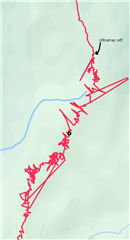For context: I do long-distance, multi-day hikes in national parks so power management on a wearable is useful to me.
I haven't taken the F6XPS out into the woods yet (because it's minus 42 degrees here) but was playing around with the Power Mode configurations and was surprised to see how (theoretically) good they are.
I normally use a chest-strap HRM (because 1-year battery life & way more accurate with trekking poles) so my comparisons factor its use.
____________________________________________________________
Custom mode created called "UltraHike" with these settings:
- GPS Normal (GPS-only)
- Music Disable
- Phone Disconnect
- Wrist HR Turn Off
- Map Disable (was "Allow" - disabled for battery life)
- Display Time Out
- Backlight Turn Off
- Accessories (eg: ANT+ HRM) Allow
89-hours battery estimate with full charge
- -11-hours if you allow Optical HR
- +10-hours if you disable accessories (ANT+ HRM)
Ergo, using an external HRM, despite enabling ANT+, doesn't cost you any battery life.
____________________________________________________________
Next step is the baked in Ultratrac mode, all the same settings as above but "Ultratrac" for GPS mode.
101-hours on a full charge.
So it seems Ultratrac (with poorer GPS tracks) only buys you about 13% extra run time versus a custom mode.
____________________________________________________________
The next jump to "Expedition" estimates 37-days of battery life, with 15-minute GPS sampling.
If I'm out longer than 3-days, I'm probably carrying heavier gear with me (food, etc) so a micro-sized power-bank wouldn't be a burden. Some people have gotten creative with those: https://forums.garmin.com/outdoor-recreation/outdoor-recreation/f/fenix-6-series/205521/portable-watch-charger/994203#994203



